#Queen Elizabeth Brooches
Explore tagged Tumblr posts
Text
Christmas jewels
In the run-up to Christmas, we’re going to be taking a look at some of the royal ladies’ Christmas themed jewels. Starting off with Queen Elizabeth’s Canadian Snowflake brooch.

The brooch was gifted to the late Queen by the Canadian Governor General in 2017 to mark 65 years on the throne.
The brooch contains diamonds and some stunning pale blue sapphires that give the snowflake design an icy look.

The brooch was worn a handful of times, including this appearance at Royal Ascot in 2019.
96 notes
·
View notes
Text
The Consort Crown & Coronation Jewels
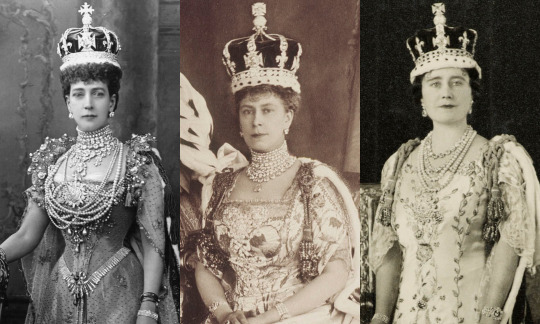
Queen Camilla has a lot of options for the jewelry that she will wear to her husband's coronation on May 6th. My predictions are based on the jewelry worn by Queen Alexandra, Queen Mary, and Queen Elizabeth, the Queen Mother, and are pretty safe choices. Other than a crown and the ring all of this jewelry is optional and Queen Camilla may decide not to wear all of it or to wear different pieces altogether.
The jewels used in the coronation are some of the most controversial ones the British Royal Family possess. I won't get into their history or what should be done with them here because plenty of others have already covered it. They have already decided to not use the Koh-i-Noor diamond but there are a few others that go along with it that are not as well know that I think should also be set aside this time around.
Queen Mary's Crown

The last few consorts have had new crowns made for them but Queen Camilla has decided to reuse Queen Mary's Consort Crown. It was made in 1911 by Garrard using over two thousand diamonds set in silver and gold. Instead of the Koh-i-Noor diamond, Queen Camilla is using the Cullinan V diamond in the center of the crown like Queen Mary did for her son's coronation in 1937. She is also going to use only four of the eight arches bringing it more in line with the other crowns used in the ceremony. All of the alterations were already possible, they just haven't been used in this exact configuration before.
The Coronation Earrings
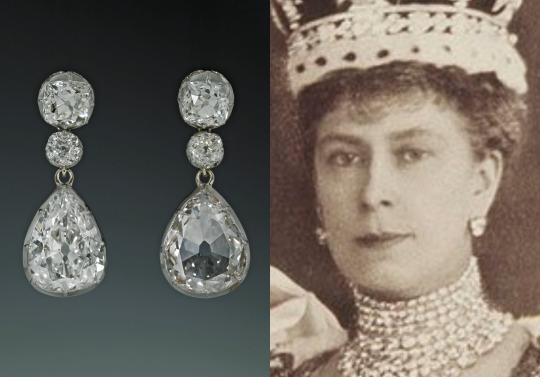
The focus is usually on the Koh-I-Noor diamond itself but going with it are the Coronation Earrings. Queen Victoria had them made using the pear shaped diamonds from the sides of the Koh-I-Noor armlet in 1858. It's sometimes a bit confusing because Queen Victoria did not wear them to her coronation but they got the name Queen Victoria's Coronation Earrings later after being worn by Queen Elizabeth and Queen Elizabeth II at their coronations. Hugh Roberts wrote that Queen Mary also wore them for her husband's coronation but in the pictures it looks like she is wearing her Diamond Collet Earrings made from extra diamonds taken from the Coronation Necklace not these. She could have worn different earrings for the pictures or just worn the tops of the earrings. I think Queen Mary's Diamond Collet Earrings are the better choice but another possibility is that Queen Camilla will wear an entirely different pair of earrings. She doesn't have pierced ears so it may be decided not to alter such old earrings.
The Coronation Necklace
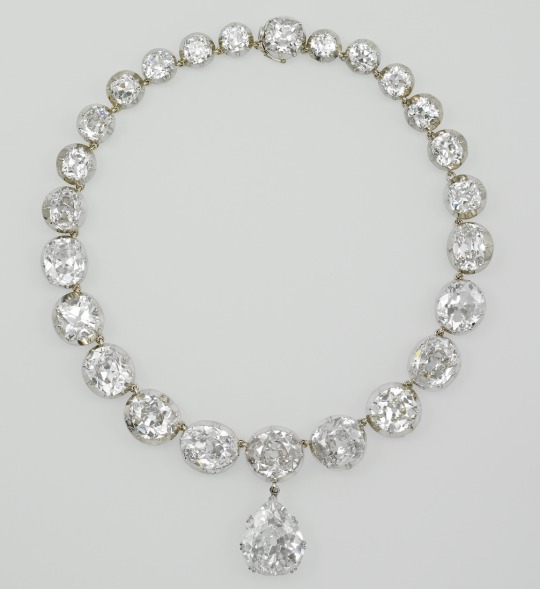
The necklace was made in 1858 by Garrard using diamonds taken from unused garter badges and a sword hilt and can be worn with the Lahore Diamond as a pendant. Like the Coronation Earrings, Queen Victoria didn't actually wear this necklace at her coronation but it has been worn at every one since. Queen Mary and Queen Elizabeth II used the pendant but Queen Alexandra and Queen Elizabeth, the Queen Mother, did not. I think it's best to not use the Lahore Diamond this time because it’s from the same collection of jewels as the Koh-i-Noor. Queen Elizabeth II regularly wore the Coronation Earrings and the Coronation Necklace with the Lahore Diamond without anyone saying anything or connecting them with the Koh-i-Noor but if there is a chance to avoid controversy they should take it.
Queen Elizabeth's Coronation Necklace
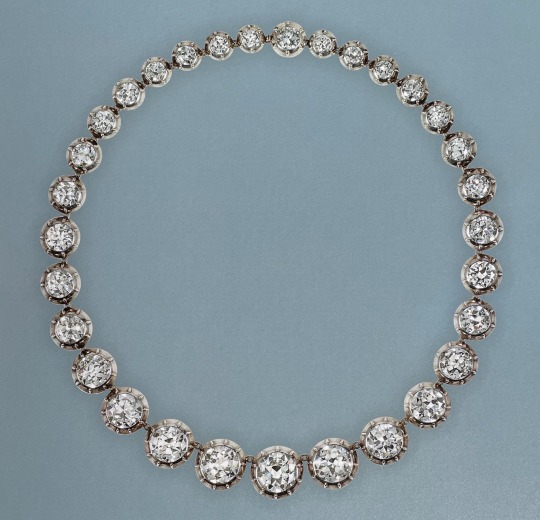
In addition to the Coronation Necklace I would like Queen Camilla to wear Queen Elizabeth's Coronation Necklace. It was a gift from King George VI to his wife for their coronation in 1937 and was worn by her along with the main coronation necklace. Queen Camilla has already worn this necklace and had is shortened from 40 to 31 diamonds. It may need to be lengthened a bit again in order to lay right with the other necklace.
The Buckle Bracelets
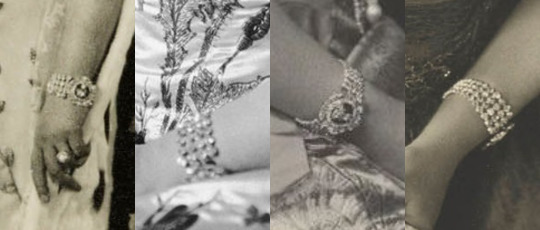
Queen Mary had these bracelets made for the 1911 coronation using two diamond and enamel buckles that belonged to King William IV attached to four rows of diamonds each. According to The Queen's Jewels by Leslie Field, one buckle features the cypher of King William IV and the other of Queen Adelaide. Queen Mary also wore them for a few portraits and Queen Elizabeth wore them for her husband's coronation in 1937 but I haven't been able to find any pictures of them being worn since then.
The Diamond Cockade Brooch
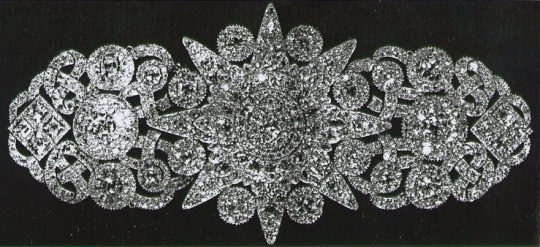
This brooch has been worn by the last three Queen Consorts. Queen Alexandra and Queen Mary both wore the full brooch but Mary turned the side sections up so it was V shaped. Queen Elizabeth only wore the central section and I think that's probably how it will be worn by Queen Camilla since the whole piece is pretty massive.
The Consort Ring
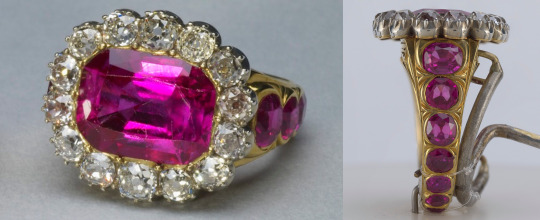
This ruby and diamond ring was made for Queen Adelaide to wear to her husband's coronation in 1831 and has been worn by every Queen Consort since. The ring is actually part of the ceremony and will be placed by the Archbishop of Canterbury on Queen Camilla's right hand.
I can’t wait to see what jewels Queen Camilla will wear! What are your predictions?
#British Coronation#Coronation#Queen Camilla#British Royal Family#United Kingdom#Queen Alexandra#Queen Mary#Queen Elizabeth#crown#ring#necklace#bracelets#brooch#royalty#royals#royaltyedit
161 notes
·
View notes
Text


CATHERINE'S STYLE FILES - 2023
11 NOVEMBER 2023 || The Princess of Wales attended the Royal British Legion Festival of Remembrance at the Royal Albert Hall along with Prince William and other of the Royal Family.
Catherine opted for -
↬ 'Jorgie' Ruched Crepe Dress in 'Black' by Emilia Wickstead
↬ Queen Elizabeth II's Bahrain Pearl Drop Earrings
↬ Queen Elizabeth II's Three-Strand Pearl Necklace
↬ 1st The Queen's Dragoon Guards Brooch in Silver
↬ Paper Poppy Pin by Royal British Legion
↬ 'Muse' Clutch Bag in 'Black Suede' by Stuart Weitzman
↬ 'Purist 105' Pumps in 'Bllack Suede' by Aquazzura
#catherines style files#style files 2023#princess of wales#the princess of wales#princess catherine#princess kate#emilia wickstead.#1st queen's dragoon guards silver brooch.#princess catherine : 1st queen's dragoon guards silver brooch.#paper poppy pin.#royal british legion.#queen elizabeth ii : three strand pearl necklace.#queen elizabeth ii : bahrain pearl earrings#queen elizabeth ii : bahrain pearl drop earrings.#stuart weitzman.#aquazzura.#british royal family#british royals#royalty#royals#royal#kate middleton#catherine middleton#duchess of cambridge#brf#british royalty#royal fashion#fashion#FestivalOfRemembrance23#11112023
26 notes
·
View notes
Text
17 notes
·
View notes
Text
Cartier Brooch with a remarkable pool of jewelry was possessed by The late Queen Elizabeth II, but limited quantities carried as much meaning as her Cartier brooch, prized at an extraordinary £100,000. This wonderful piece was a portion of the floral design tiara, gifted to her on her wedding day in 1947 by the Nizam of Hyderabad, one of the wealthiest men of that period. The tiara and identical necklace were precisely crafted from platinum and decorated with diamonds, with a sparkling headpiece that contained three detachable brooches. These equity stones, which could be depicted as roses, became a long-lasting sign of her lengthy reign and her matchless capacity to pass a special touch to all she wore.
0 notes
Text




Sunderland's Royal Jewel Vault (51/∞) ♛
↬ Princess Elizabeth's Sapphire Scroll Tiara
As the elder daughter of George II and an aunt of Louis V, Princess Elizabeth was an uncontroversial member of the royal family with a remarkable jewellery collection; including her great-grandmother’s sapphire tiara, a fringe tiara, and this sapphire scroll tiara. Comprised of a large detachable sapphire brooch, the tiara is said to have originated from Imperial Russia. Like many Romanov jewels, it was smuggled to Sunderland to escape the Bolsheviks. It was snapped up by Queen Matilda Mary for an unknown price shortly after that. The jewel lingered in the vault for a time before it was gifted to Matilda Mary’s eldest granddaughter, Princess Elizabeth, ahead of her debut in the mid-1930s. By then, the seventeen-year-old princess was the only child of George II and Anne to remain at home with her parents. Elizabeth's brothers were undergoing military training, and her only sister, the pugnacious Princess Alice, had been sent away to boarding school. Elizabeth led a lonely adolescence at Chester Palace, never showing an interest in court life or art, to her mother's great chagrin. "Her Majesty treats the Princess Elizabeth more like a pet than a daughter," a family acquittance noted. "She has a little bell to ring whenever she wants Elizabeth to fetch something or do some minimal task. Mostly Elizabeth just stands there with her hands at her side . . . as if standing at attention." Elizabeth married "silently" in 1942. Her husband, a reclusive but wealthy earl, was fifteen years her senior, but Queen Anne remarked that Elizabeth "seemed to like" him. The Queen was equally pleased when Elizabeth gave birth to a son, the first grandson of George II, less than a year into the marriage. Elizabeth's monotonous domestic life was briefly interrupted when Sunderland declared war on Nazi Germany, formally entering the Second World War. Elizabeth worked with the Red Cross and funded welfare projects to support the families of conscripted soldiers. The Princess maintained her public duties after the war, but interpersonally, she remained distant and "chronically unamused." "She is a Hohenzollern to the core & with the personality of a lemon that has been sucked dry," Queen Katherine later wrote. "Always muttering under her breath. Too much of her grandmother's dreadful disposition! Awful." Throughout her years of public service, Elizabeth wore her sapphire scroll tiara to many important events, including the enthronements of her brother, James II, and nephew. After Elizabeth died in 1995, her surviving son sold most of her jewels, including the tiara, which fetched a staggering $18,200 in 2000. Creation: Unknown Provenance: 1) Queen Matilda-Mary 2) Princess Elizabeth of Sunderland 3) Private owner Status: Sold
#warwick.jewels#✨#ts4#ts4 royal#ts4 edit#ts4 royal legacy#ts4 legacy#ts4 royalty#ts4 monarchy#ts4 screenshots#gif warning#sims 4#simblr#the sims 4#sims#the sims community#sims 4 screenshots#my sims#ts4 simblr#warwick.extras
72 notes
·
View notes
Text




Mana's Favorite Outfit
1997 at NIHON SEINENKAN & SHIBUYA KOKAIDO
Hair Accessory: An elaborate hairpiece featuring blue and black feathers, matching the outfit.
Collar: A luxurious design reminiscent of nobility, adorned with a gold brooch at the center of the ribbon.
Sleeves: Detailed with fine pleats to create a flared effect.
Skirt: An over-skirt with black feathers, giving the outfit a streamlined appearance.
Mana (from Stylist)
This outfit was inspired by the image of Queen Elizabeth. Despite being a dress the mini skirt element adds a unique touch. The over-skirt flutters beautifully when moving. It's rare to see a mini skirt on a dress, and I wanted to maintain a sense of elegance while showing some leg. The combination of a dress with visible legs adds a certain eroticism. It was especially memorable for me as it was worn on a major stage for the first time at the Nihon Seinenkan and Shibuya Kokaido.

#malice mizer#mana sama#kami malice mizer#malice mizer közi#magazine#malice mizer mana#yu~ki malice mizer#malice mizer gackt
106 notes
·
View notes
Text
Random Doctor Who Facts You Might Not Know, Part 23
River Song chose Bernice Summerfield as her tutor in university because she knew the Doctor. Benny remembers that she was the most annoying student she ever had, rarely attended class, but still graduated on top.
Not only does the Sixth Doctor wear a cat brooch, but he wears cat cufflinks too.
Jenny had managed to track the Eleventh Doctor down during the Siege of Trenzalore but was unable to get to him due to the forcefield kept by the Papal Mainframe.
The Sixth Doctor has twelve identical spare coats in the TARDIS wardrobe.
Leela once stabbed the Second Doctor with a Janus thorn. Jamie immediately began a knife fight with her in response.
Peri Brown once had to disguise herself as Queen Elizabeth I, big dress and all. The Sixth Doctor was much more amused by this than she was.
When Helen first became a companion, she thought the Eighth Doctor was scary.
After the Twelfth Doctor kicked Rassilon off Gallifrey, Rassilon allied himself with the Cybermen, was converted into the CyberPresident, and created an alternate timeline where the Cybermen had taken over the universe. This timeline was later eradicated.
There are 76 different color tones in the Sixth Doctor's coat.
While at university, River stole a vortex manipulator in order to get help from her future self on essays. The reason she wasn't expelled was because she argued that it was impossible to plagiarize off of herself.
When listening to a device that sounds like the voice of someone the listener admires and respects, Ianto heard Jack, and Jack heard the Tenth Doctor.
In a parallel universe, Rob Tyler was the son of Jackie and Pete Tyler. He was the male counterpart of Rose and in a relationship with Mickey.
By one account, Rassilon’s first body was male; by another, female.
After a conversation with the Third Doctor, River became convinced that the Sixth Doctor was copying her hair.
After learning about messages in bottles, Jenny wrote to the Doctor, hoping it would one day find them.
Dalek juice is a beverage made from the secretions that come out of a Dalek as it is tortured.
The Sixth Doctor developed a weak form of night vision from the carrot juice Mel had him drink.
Jamie has disguised himself as a woman on two different occasions (that I can think of).
Part 1, 2, 3, 4, 5, 6, 7, 8, 9, 10, 11, 12, 13, 14, 15, 16, 17, 18, 19, 20, 21, 22, 23, 24, 25, 26, 27, 28
#doctor who#dw#dr who#classic who#new who#eighth doctor#fifth doctor#big finish#sixth doctor#big finish audios#big finish doctor who#river song#bernice summerfield#dw eu#doctor who eu#doctor who expanded universe#rose tyler#jamie mccrimmon#leela#leela of the sevateem#second doctor#mel bush#helen sinclair#peri brown#jenny the doctor's daughter#eleventh doctor#twelfth doctor#tenth doctor#jack harkness#third doctor
172 notes
·
View notes
Text
Lovers' Knot Brooch
I love bow brooches, and this one is a different, and very pretty, take on the bow brooch. The brooch was bought by Queen Mary from Garrard in 1932, and passed on to her granddaughter, Queen Elizabeth, in 1953. Since then, the Late Queen wore the brooch on many occasions, including the marriage of Prince William and Catherine Middleton.

43 notes
·
View notes
Text

The Duchess of Teck's Pearl and Diamond Brooch
When Queen Mary’s brother Prince Frank died in 1910, they had just repaired a decade long rift, during which he altered his will to reflect his feelings towards his sister.
James Pope-Hennessy said around this time (when his sister has just recently become Princess of Wales) Prince Frank was alienated from her due to her disapproval of his mistress Nellie, Countess of Kilmorey as well as her attempts to help him “with money and good advice.” He says Frank found, “the burden of gratitude too heavy to bear.”

Frank’s will states, “The jewel given me by my godfather Francis Joseph Emperor of Austria I leave to Eleanor Constance, Countess of Kilmorey with the caveat that she will leave it to H.R.H. The Princess Victoria of Great Britain and Ireland daughter of His Majesty King Edward VII and Queen Alexandra.”
Queen Mary was horrified by the contents of the will and in 1910 paid the Countess £10,000 for the Cambridge emeralds to be returned to her. But this jewel was not included in that purchase. The Countess died in 1920 and the brooch presumably went to Princess Victoria. The brooch was later either given to or left to Queen Mary by Princess Victoria (who died in 1935) and was later photographed in her photographic jewel inventory. She left it to Queen Elizabeth II in 1953. The brooch has now presumably been left to King Charles.
~ British Royal Jewels IG

#queen elizabeth ii#british royal family#jewel;brooch#the duchess of teck's pearl and diamond brooch#thejewelcatalogue#source;britishroyaljewelsig
170 notes
·
View notes
Note

Do you think the new portrait is Mary I?
I think it's certainly possible it is Mary I. I have in past voiced strongly that it bears a much stronger resemblance to Mary I than to Catherine Parr. Mary wins over in features. Against Parr.
However, if we look at images that I think could be Catherine Howard-then I am undecided if it is Mary indeed.
But unless we have multiple confirmed images of Catherine Howard, it is impossible to tell definitely which one it is.
(The miniature in RCT with a 'consort pendant' is Anne of Cleves. I think I proved that enough on this blog. Hence we have zero of confirmed Howard this far.)
Until we do have such an option I am happy to call it Mary I instead of Catherine Parr. I am glad they changed it, I am hoping in future they will rename alleged Mary Howard's miniature(which has Parr's features through and through).
Unfortunately, I am skeptical of the dating of this miniature and thus the attribution to Susanna Horenbout.
Certainly, the records of the cross that matches are a good sign. Unfortunately, it's not as big evidence as they think it is.
Portraying delicate pieces of jewelry on miniatures was very difficult and not always does it do justice. (For example- the IHS brooch on Catherine of Aragon's miniature is nearly unrecognizable. It is the same Jane Seymour wears in her portrait by Holbein.)
In this case, however the jewel is clearly visible and should be fairly recognizable. So, why do they mention Mary wearing a clearly different cross in the NPG miniature by Lucas Horenbout?
It is not making their case stronger at all.
Religious jewelry was popular. Crosses with pearls and diamonds were common. So, how can you be sure it is the exact one you think it is?
-Realistically I don't think you can. It's not unique enough to be a good indicator.(There are only so many variations of cross-shaped jewelry you can make! Normal cross typically fits 5 to 6 gemstones across centuries, and up to 3 hunting pearls-a common part of jewelry in the Tudor era.)
So crosses matching the same description could be multiple within the royal family(and in the royal collection to which mary had access to), maybe even in Mary's own possession prior to 1546.
Hence yes it is a point for Mary, but it is not a strong point.
Certainly not the thing you can base dating solely on.
While the French hood's shape, nor partlet are not that far off from 1546, the way to date French hood in the 1540s is by looking at the hair.
And it is pretty simple.
Early you start with straight hair, closely fallowing head, not sticking out at all(Anne of Cleves-alleged miniature of Howard)
Then in c.1540-1543, we start to see hint of buns(slightly starting to poke out), but also simultaneously first slightly curly/wavy examples, still closely fallowing head, and it is pretty rare for them to stick out.
Parr in c.1543 juggles both hairstyles, but it sems curly/wavy was temporarily her preferred style, but it sticks out way more.
In 1544 Mary's portrait-curly hair.
But Parr in c.1545 has two straight buns down-returning to it-but again, it is more pulled out. Elizabeth in c.1546 has hair straight in two buns down. Margaret Douglas(possibly) in c.1546 has two straight buns down.
And c.1547/8 examples of Mary and Elizabeth show both buns up(the style then extends to 1550s-is typical for them, but starts in late 1540s)
So there is a clear pattern. Which art historians are yet to discover.
And they don't have it easy. Because, the official dating of 1540s, and 1550s portraits is nightmare. Most recent(before this) portrait to be misdated was the Jersey portrait of Parr. It was officially dated as 1547-1548.
Solely because she wears black-she must be a widow! (sarcasm.) Yeah, maybe in Victorian times. This is the Tudor Queen. She can wear black normally. No case for that date whatsoever!
-No, Parr's portrait is c.1544, it matches Mary's 1544 portrait so much! Except for the stays.
With so many examples of inaccurate dating between 1540-1560, it is no wonder historians then make wrong assumptions, based upon them.
Ooops-got bit sidetracked.
Mary's miniature imo is from early 1540s, c.1540-1542.
Hair is closely fallowing head, not sticking out at all nor any hint of buns, only slightly wavy. So almost same as in 1530s.
It's not consistent with any of the hairstyles seen in Parr's reign, but rather with Holbein's late work. He died in 1543.
It is basically the french hood and hairstyle from image on right

-just in different angle and with different billements, and bit more spread partlet(not by much though-it is wider at Parr's reign).
Maybe like this you will be able to better see the french hood's similiarity.

(the piece behind ear often gets later altered(overpainted).)
So with dating of 1540-1542. I am sorry, but Lucas Horenbout is still in the picture. He died in 1544. But that doesn't mean it should be just broadly atributed to 'workshop of Horenbout family'. His father seems to be not working by this point. His wife possibly was artist, but unlikely to have that similiar style to Lucas.
Since this is strongly Horenbout style...it should be one of the siblings.
But I think there is nothing wrong in attributing it to both siblings in case of ambiguity.
Hence I would label it as:
Miniature portrait of Queen Mary I as Princess, in c.1540-1542, by Lucas or Susanna Horenbout

Until proven otherwise.
15 notes
·
View notes
Text

The Princess of Wales wore Queen Elizabeth II’s Pearl Leaf Earrings for the first time for a ceremony at the Cenotaph on Remembrance Sunday.
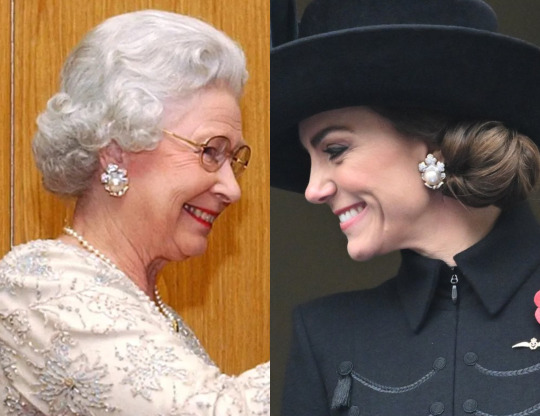
The earrings match the Pearl & Diamond Leaf Brooch that the Princess of Wales has been wearing since 2017 usually at similar remembrance type events. The earrings are new to me but CoutureRoyals on Twitter found a picture of the late Queen wearing them.

It’s possible that they are two of the leaves from the brooch set as earrings. We’ll have to wait and see if they are ever worn at the same time.

185 notes
·
View notes
Text
The Princess of Wales is wearing a new brooch she was presented with during her visit with the 1st The Queen's Dragoon Guards regiment in Norfolk along with a pearl necklace belonging to Queen Elizabeth II, which was gifted to her by her father - King George VI and the Bahrain Pearl Drop Earrings.


122 notes
·
View notes
Text
Happy 101st Anniversary to Bertie & Elizabeth
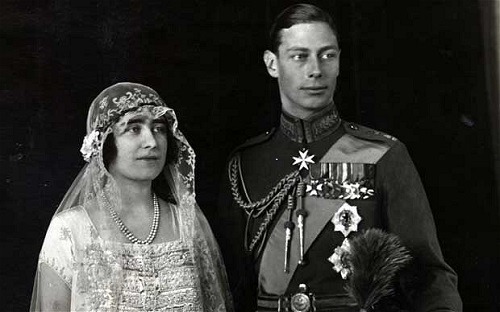
The Duke & Duchess of York on their wedding day, April 26, 1923.
The young royals had no idea that 13 years later they would become King George VI & Queen Elizabeth.
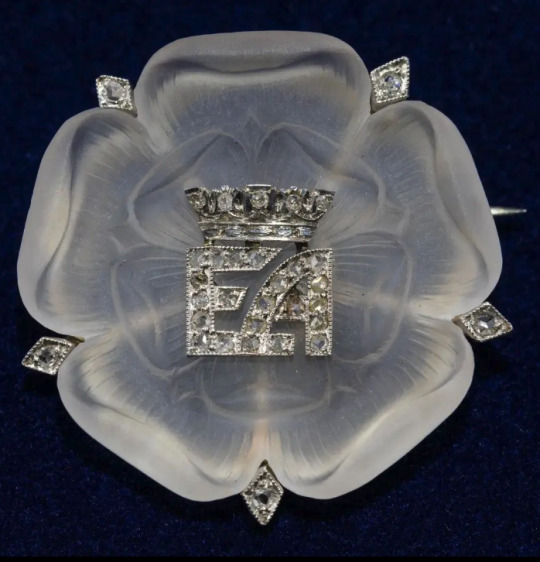
Prince Albert's gift to Elizabeth's bridesmaids was an exquisitely carved crystal brooch of the white Rose of York with the couple's monogram (E A) and the ducal crown in diamonds. I really love how modern the style of the cypher is! Very reflective of the Deco period.

If you look carefully at the wedding portrait, you can see the bridesmaids wearing the brooch. It's a lovely small size; not too much!

Just Married!!
Throwing this one in for fun 'coz you can tell they are smiling even from behind. :)

The newly married Duke & Duchess of York leaving Buckingham Palace for their honeymoon. The Duke is getting pelted with confetti by his brothers.

Theirs is such a beautiful love story. ❤️💍❤️
RCT, thebeaumondecollection,
#bertie & elizabeth#true love 💘#duke and duchess of york#king george vi#queen elizabeth#April 26#1923#happy anniversary#british royal family
30 notes
·
View notes
Text
Cartier Brooch with a remarkable pool of jewelry was possessed by The late Queen Elizabeth II, but limited quantities carried as much meaning as her Cartier brooch, prized at an extraordinary £100,000. This wonderful piece was a portion of the floral design tiara, gifted to her on her wedding day in 1947 by the Nizam of Hyderabad, one of the wealthiest men of that period. The tiara and identical necklace were precisely crafted from platinum and decorated with diamonds, with a sparkling headpiece that contained three detachable brooches. These equity stones, which could be depicted as roses, became a long-lasting sign of her lengthy reign and her matchless capacity to pass a special touch to all she wore.
Utilization of Cartier Brooch
Over the years, the Queen frequently selected to dress the Cartier brooch separately or as a pair, viewing her concrete sense and love for timeless style. This iconic piece, which was later, passed down inside the Royal Family, was raised out as a climax in the royal family’s collection. Even during her rule, her jewelry picks, like the five-strand necklace containing 300 carats of gems, left jaws dropping at ostentatious occasions, such as a gala at the National Portrait Gallery in London
0 notes
Text




Sunderland's Royal Jewel Vault (39/∞) ♛
↬ The Duchess of Westminster's Star Tiara
Made in the nineteenth century, this diamond tiara features prominent star clip brooches that once belonged to Princess Amelia of Sunderland (a daughter of King Louis II). It was inherited by Amelia’s namesake and goddaughter Princess Amelia Elizabeth of Westminster in 1870. By 1891 Amelia Elizabeth had altered the stars into a flexible headband, and in 1902, a tiara base featuring scrolling elements was added. Ultimately, Amelia Elizabeth left the tiara to her eldest daughter, Helen. Despite having four children of her own, the tiara didn’t stay within Helen’s family, instead falling into the hands of her cousin: Queen Anne of Sunderland. Since then the jewel has stayed with the Warwicks. It was handed over to Anne’s daughter-in-law, Queen Katherine, in the late 1950s. Katherine wore the piece a few times during her husband’s reign, but was shelved in 1960, having never been Katherine’s favourite. In more recent years, the tiara was loaned to Tatiana, Princess of Danforth, one of the three tiaras she received from her in-laws in the late 90s and early 00s. Tatiana has yet to wear the piece as a tiara, instead opting for its original brooch setting. Creation: Early nineteenth century, altered in 1891 by court jeweller Albemarle Provenance: 1) Princess Amelia of Sunderland 2) Princess Amelia Elizabeth, Duchess of Sunningdale 3) Helen, Marchioness of Dufferin 4) Queen Anne of Sunderland 5) Queen Katherine of Sunderland 6) Queen Irene of Sunderland Other wearers: Tatiana, Princess of Danforth Commissioned/Purchased by: Princess Amelia of Sunderland Status: On loan to Tatiana, Princess of Danforth
#warwick.jewels#✨#ts4#ts4 story#ts4 royal#ts4 storytelling#ts4 edit#ts4 royal legacy#ts4 legacy#ts4 royalty#ts4 monarchy#ts4 screenshots#gif warning#warwick.extras
59 notes
·
View notes